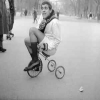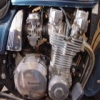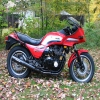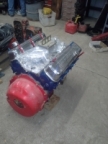- Posts: 1413
- Thank you received: 36
Brake problems on a KZ900
- mtbspeedfreak
-
Topic Author
- Offline
- User
I just put in a new set of sintered brake pads on a stock '76 KZ900. The brakes drag quite noticeably. I balled up a paper towel to suck up some of the fluid in the master cylinder, but I don't think too much brake fluid is the problem. I gently used a c-clamp to force the piston back into the bore and I've slid the caliper as far as I can.
I know pads have a bedding-in time, but are there any special tricks for changing brake pads on a KZ900?
2000 ZRX 1100
1976 KZ 900- Daily Driver
1980 LTD 550- Dalton Highway survivor!
If it has tits or tires, it'll give you problems!
Please Log in or Create an account to join the conversation.
- Kidkawie
-

- Offline
- User
- I bleed premix
- Posts: 1919
- Thank you received: 245
1975 Z1 900
1994 KX250 Supermoto
2004 KX125
Please Log in or Create an account to join the conversation.
- trianglelaguna
-

- Offline
- User
- New and improved - extra strength
- Posts: 8726
- Thank you received: 235
1976 KZ900
2003 ZX12R
2007 FZ1000
2004 ninja 250R for wife
Please Log in or Create an account to join the conversation.
- newOld_kz1000
-

- Offline
- User
- FlimFlamFlibbityFlee !! BoonFryedShickaMuhZee !!
- Posts: 751
- Thank you received: 20
The bike had sat for a while. No amount of bleeding would get the puck aka 'brake piston' to move correctly back and forth in the bore of the caliper. The brake was really dragging.
I did this:
1) disconnected the brake hose at the caliper
2) removed the caliper
3) see how dirty it was (rear caliper '78 kz1000)
4) I pulled the puck out, it had a line of dirt/gunk/surface rust, cleaned it off with #000 steel wool and Palmolive ("it softens hands and '78 kz brake pucks") dishwashing soap, outta one of them green kitchen squeeze bottles
5) inside the bore of the caliper, which you can see after removing the puck, is a rubber o-ring. THAT SUCKER IS WHAT PULLS THE BRAKE PUCK BACK INSIDE when you let go the brake. THAT PART IS NOT WORKING FOR YOU RIGHT NOW. It's because your puck has a ring of junk on it, maybe, like mine did. When you remove the oring, CLEAN OUT THE GROOVE so the oring will be able to do its job -- you will probably find a bunch of dried brake fluid inside the oring groove. And don't forget step (4) above also. Now, when the outside surface of the puck is clean; and when this oring and its groove are clean; then the brake puck should move back-and-forth, inside-and-out of the caliper bore under normal riding conditions. Dont put the rubber oring back in the groove in the caliper bore yet.
6) Now wipe down the bore and the brake fluid channels in the caliper -- I used IPA, 'rubbing alcohol', aka "isopropyl alcohol, 'IPA' -- clean any residue off the puck after you done step (4) above with IPA too. Clean the oring with IPA too. DONT put the oring back in the caliper bore yet.
7) Test how successful you were at removing that circle of gunk you found on the outside surface of the puck -- do the following *before* you re-install the rubber oring. Put some brake fluid around the outer surface of the puck and on the inside of the caliper bore. Now slide the puck into the bore and make sure the puck moves FREELY in-and-out of the caliper bore. If it dont then do step (4) a bit, maybe you didn't get all the surface junk off that puck.
9) now put a bit more fresh brake fluid on the puck and slide it in to the caliper. You can push it all the way down because when you go to bleed it, the bleeding process will ultimately set the right position of the puck. Note: since in this step the rubber oring's already inside the caliper it *will* require more effort to slide the brake puck into the caliper.
Then reassemble the caliper and bleed it, and you will probably find NO MORE STICKING.
NOTE: if the above does not work, there is a tiny return fluid hole in the master cylinder that may be blocked. I just fixed that problem on yet another bike, a '81 gs1100 Suzuki. The return or 'relief' fluid hole got clogged and once I applied the brake, the relief hole would not allow brake fluid to flow back out of the caliper when the brake lever was released, and so the puck just stuck hard in the 'on' position, with the brake really dragging. So if you know your caliper is spotless, you might check the relief hole on the master cylinder.
Have at it good luck.
1978 kz1000 A2 with Kerker
1980 Z1 Classic with Kerker
Please Log in or Create an account to join the conversation.
- mtbspeedfreak
-
Topic Author
- Offline
- User
- Posts: 1413
- Thank you received: 36
I have not rebuilt the caliper yet- I'm hoping to put that off until I purchase a dual disc kit and run DOT 5 fluid.
I haven't had the wheel off the bike since I first changed the pads (working on other odds and ends on the bike- if it has tits or tires, it'll give you problems!) and the weather has been too rainy to run around the block testing the brakes [not expecting the brake to function properly, but it does after you've locked up the front on the wet pavement
I'll see where I stand in a day or two, I'm hoping the weather clears up tomorrow for a bit.
2000 ZRX 1100
1976 KZ 900- Daily Driver
1980 LTD 550- Dalton Highway survivor!
If it has tits or tires, it'll give you problems!
Please Log in or Create an account to join the conversation.
- Kidkawie
-

- Offline
- User
- I bleed premix
- Posts: 1919
- Thank you received: 245
1975 Z1 900
1994 KX250 Supermoto
2004 KX125
Please Log in or Create an account to join the conversation.
- TomW
- Offline
- User
- Keep the blue side up.
- Posts: 502
- Thank you received: 52
FYI
Brake fluid facts
By Steve Wall
As a former materials engineering supervisor at a major automotive brake system supplier, I feel both qualified and obligated to inject some material science facts into the murky debate about DOT 5 verses DOT 3-4 brake fluids. The important technical issues governing the use of a particular specification brake fluid are as follows:
*
Fluid compatibility with the brake system rubber, plastic and metal components.
*
Water absorption and corrosion.
* Fluid boiling point and other physical.
* Brake system contamination and sludging.
Additionally, some technical comments will be made about the new brake fluid formulations appearing on the scene.
First of all, it's important to understand the chemical nature of brake fluid. DOT 3 brake fluids are mixtures of glycols and glycol ethers. DOT4 contains borate esters in addition to what is contained in DOT 3. These brake fluids are somewhat similar to automotive anti-freeze (ethylene glycol) and are not, as Dr. Curve implies, a petroleum fluid. DOT 5 is silicone chemistry .
Fluid Compatibility
Brake system materials must be compatible with the system fluid. Compatibility is determined by chemistry, and no amount of advertising, wishful thinking or rationalizing can change the science of chemical compatibility. Both DOT 3-4 and DOT 5 fluids are compatible with most brake system materials except in the case some silicone rubber external components, such as caliper piston boots, which are attacked by silicon fluids and greases.
Water absorption and corrosion
The big bugaboo with DOT 3-4 fluids always cited by silicone fluid advocates is water absorption. DOT 3-4 glycol based fluids, just like ethylene glycol antifreezes, are readily miscible with water. Long term brake system water content tends to reach a maximum of about 3%, which is readily handled by the corrosion inhibitors in the brake fluid formulation. Since the inhibitors are gradually depleted as. Since the inhibitors are gradually depleted as they do their job, glycol brake fluid, just like anti-freeze, needs to be changed periodically. DOT 5 fluids, not being water miscible, must rely on the silicone (with some corrosion inhibitors) as a barrier film to control corrosion. Water is not absorbed by silicone as in the case of DOT 3-4 fluids, and will remain as a separate globule sinking to the lowest point in the brake system, since it is more dense.
Fluid boiling point
DOT 4 glycol based fluid has a higher boiling point ( 446°F) than DOT 3 ( 446 ºF), and both fluids will exhibit a reduced boiling point as water content increases. DOT 5 in its pure state offers a higher boiling point (500°F) however if water got into the system, and a big globule found its way into a caliper, the water would side at temperatures very much below freezing, let alone at 40° below zero, silicone's low temperature advantage won't be apparent. Neither fluids will reduce stopping distances.
With the advent of ABS systems, the limitations of existing brake fluids have been recognized and the brake fluid manufacturers have been working on formulations with enhanced properties. However, the chosen direction has not been silicone. The only major user of silicone is the US Army. It has recently asked the SAE about a procedure for converting from silicon back to DOT 3-4. If they ever decide to switch, silicone brake fluid will go the way of leaded gas.
Brake system contamination
The single most common brake system failure caused by a contaminant is swelling of the rubber components (piston seals etc.) due to the introduction of petroleum based products (motor oil, power steering fluid, mineral oil etc.) A small amount is enough to do major damage. Flushing with mineral spirits is enough to cause a complete system failure in a short time. I suspect this is what has happened when some car owners changed to DOT 5 (and then assumed that silicone caused the problem). Flushing with alcohol also causes problems. Older brake systems should be flushed only with DOT 3 or 4.
If silicone is introduced into an older brake system, the silicone will latch unto the sludge generated by gradual component deterioration and create a gelatin like goop which will attract more crud and eventually plug up metering orifices or cause pistons to stick. If you have already changed to DOT 5, don't compound your initial mistake and change back. Silicone is very tenacious stuff and you will never get it all out of your system. Just change the fluid regularly. For those who race using silicone fluid, I recommend that you crack the bleed screws before each racing session to insure that there is no water in the calipers.
New developments
Since DOT 4 fluids were developed, it was recognized that borate ester based fluids offered the potential for boiling points beyond the 446°F requirement, thus came the Super DOT 4 fluids - some covered by the DOT 5.1 designation -which exhibit a minimum dry boiling point of 500°F (same as silicone, but different chemistry).
Additionally, a new fluid type based on silicon ester chemistry (not the same as silicon) has been developed that exhibits a minimum dry boiling point of 590°F. It is miscible with DOT 3-4 fluds but has yet to see commercial usage."
I learned in the past thru others mistakes not to switch to DOT 5 in systems designed for DOT 3 or 4.
Tom
'78 KZ1000B2 LTD stock + Vetter Fairing & luggage
'91 ZG1200B5 Voyager XII, stock
Please Log in or Create an account to join the conversation.
- mtbspeedfreak
-
Topic Author
- Offline
- User
- Posts: 1413
- Thank you received: 36
The inboard pad, the one that was secured to the caliper, is worn much more than the outboard pad, the pad which the piston pushes. This would mean the caliper is sticking to the carrier bolts, correct?
Also, I'm in the midst of a n00b moment- I cannot get the piston out of the bore? I carefully pulled the dust seal off and tried just about everything within reason to push it out... :S I don't have an air compressor, I used a can of CO2- typically to dust my keyboard. I'll probably have to make a quick trip to a tire shop tomorrow morning.
2000 ZRX 1100
1976 KZ 900- Daily Driver
1980 LTD 550- Dalton Highway survivor!
If it has tits or tires, it'll give you problems!
Please Log in or Create an account to join the conversation.
- Dragone
-

- Offline
- User
- Posts: 34
- Thank you received: 0
Careful with the air compressor, because if it is sticking now, a high boost of pressure to dislodge the piston may make it a missile. Sometimes a rubber strap wrench is enough to twist a frozen/sticking piston out as well using quantities of wd40 or rust buster.
Please Log in or Create an account to join the conversation.
- Polar_Bus
-

- Offline
- User
- Posts: 256
- Thank you received: 7
I wound up pulling the caliper off to rebuild it. I decided decent brakes were one thing that I'd like to know I can rely on, when the need arises.
The inboard pad, the one that was secured to the caliper, is worn much more than the outboard pad, the pad which the piston pushes. This would mean the caliper is sticking to the carrier bolts, correct?
Also, I'm in the midst of a n00b moment- I cannot get the piston out of the bore? I carefully pulled the dust seal off and tried just about everything within reason to push it out... :S I don't have an air compressor, I used a can of CO2- typically to dust my keyboard. I'll probably have to make a quick trip to a tire shop tomorrow morning.
This is a tell tale sign you have corrosion on the inside of the piston bore. I've rebuilt severall calipers over the years and they all exibit the same behavior as to what you are describing. Mositure within the brake fluid wreaks havoc in a 30 year old braking system. All's that's needed is to use some fine emery cloth and some oil to clean the corrosion off the piston and bore.
Bikes:
'84 GPz1100
'06 HD Fatboy
Please Log in or Create an account to join the conversation.
- Kidkawie
-

- Offline
- User
- I bleed premix
- Posts: 1919
- Thank you received: 245
Clean those carrier bolts real good and grease them.
1975 Z1 900
1994 KX250 Supermoto
2004 KX125
Please Log in or Create an account to join the conversation.
- PLUMMEN
-

- Offline
- User
- Posts: 8139
- Thank you received: 104
if you have a little extra time run those slider bolts to local plating shop for a quick trip through the tank to make em shiny,they slide much easier and will last a long time that way.
might as well yank the master cylinder and clean it and all the rubber parts also
Still recovering,some days are better than others.
Please Log in or Create an account to join the conversation.

